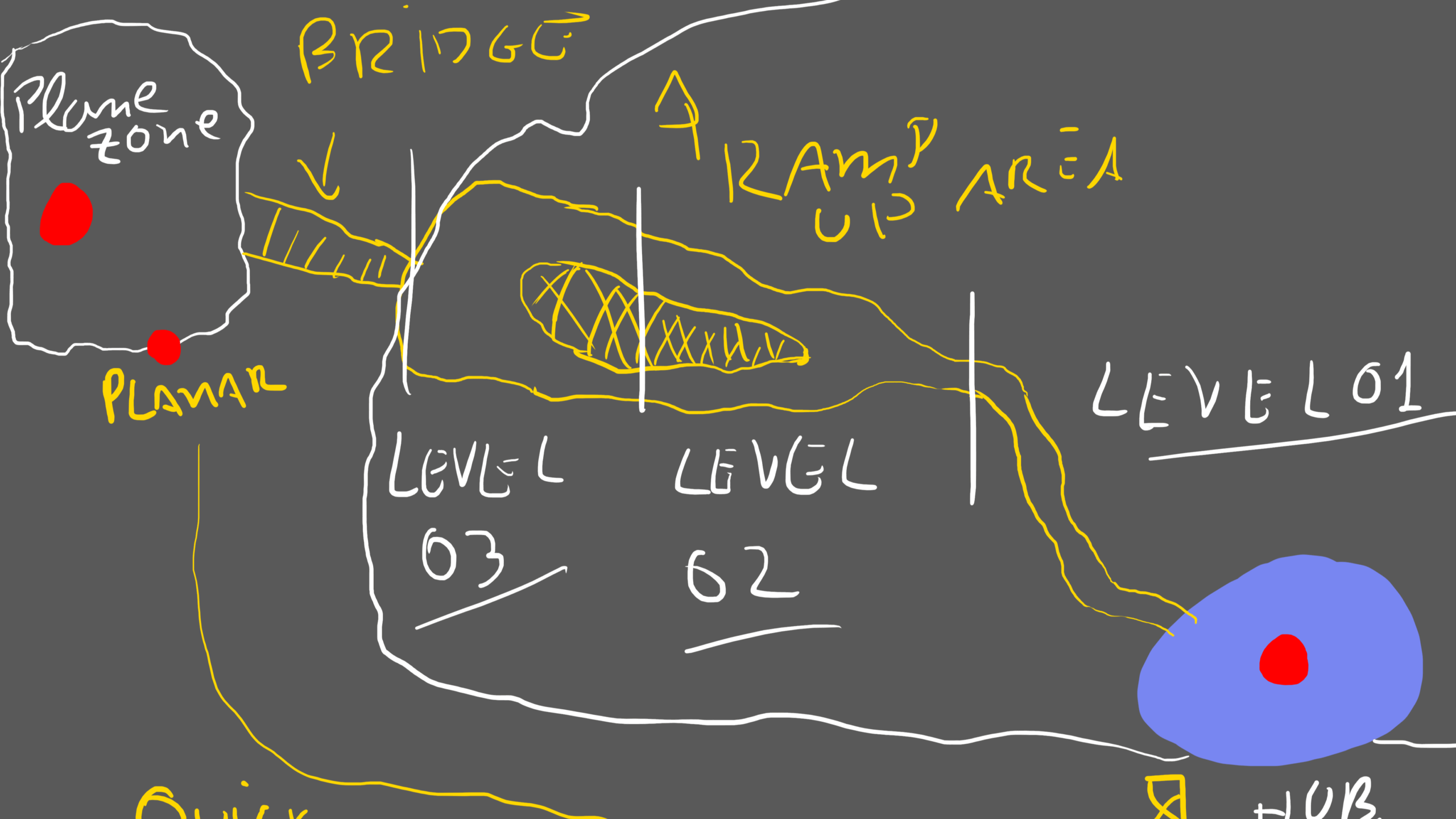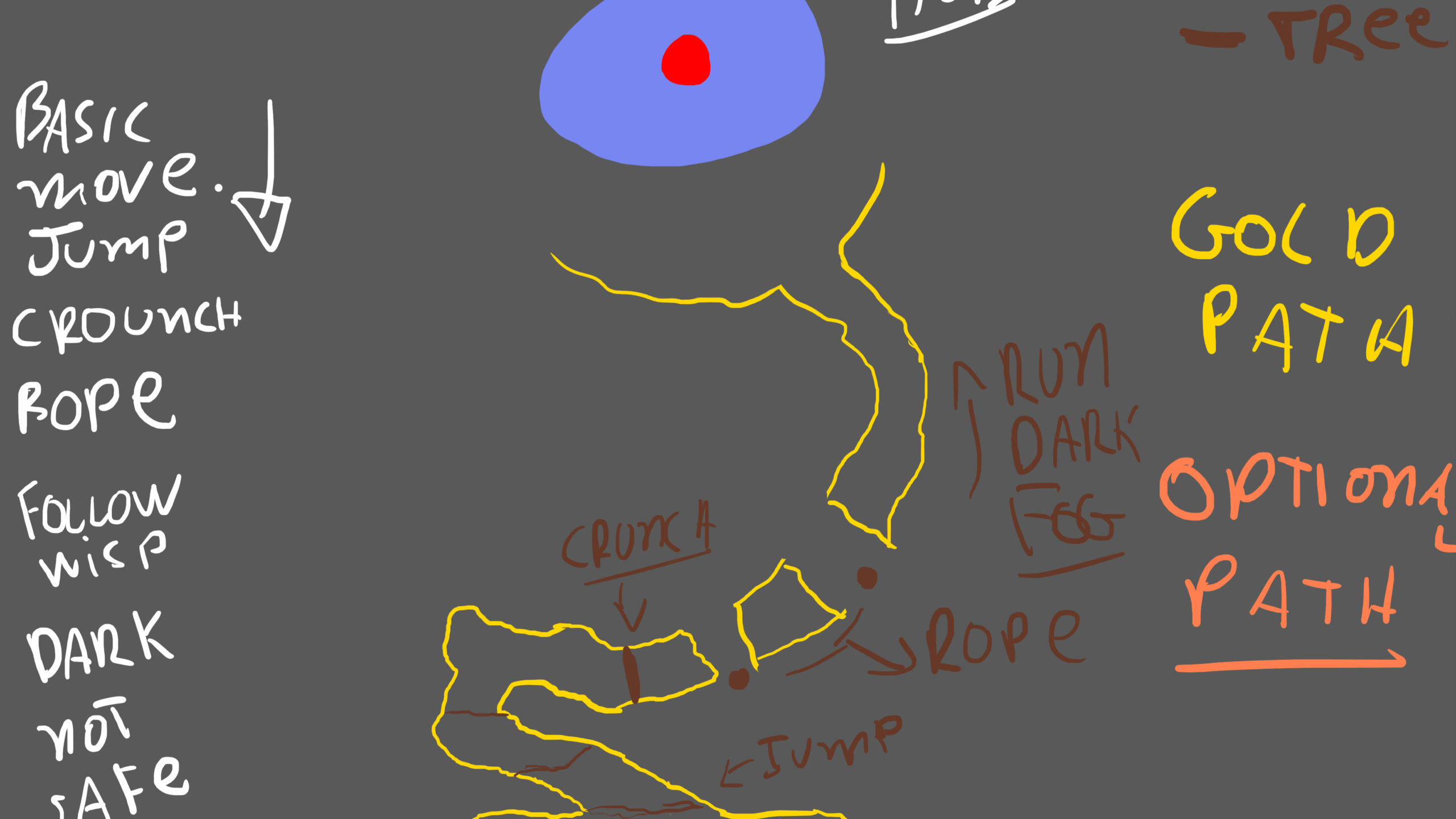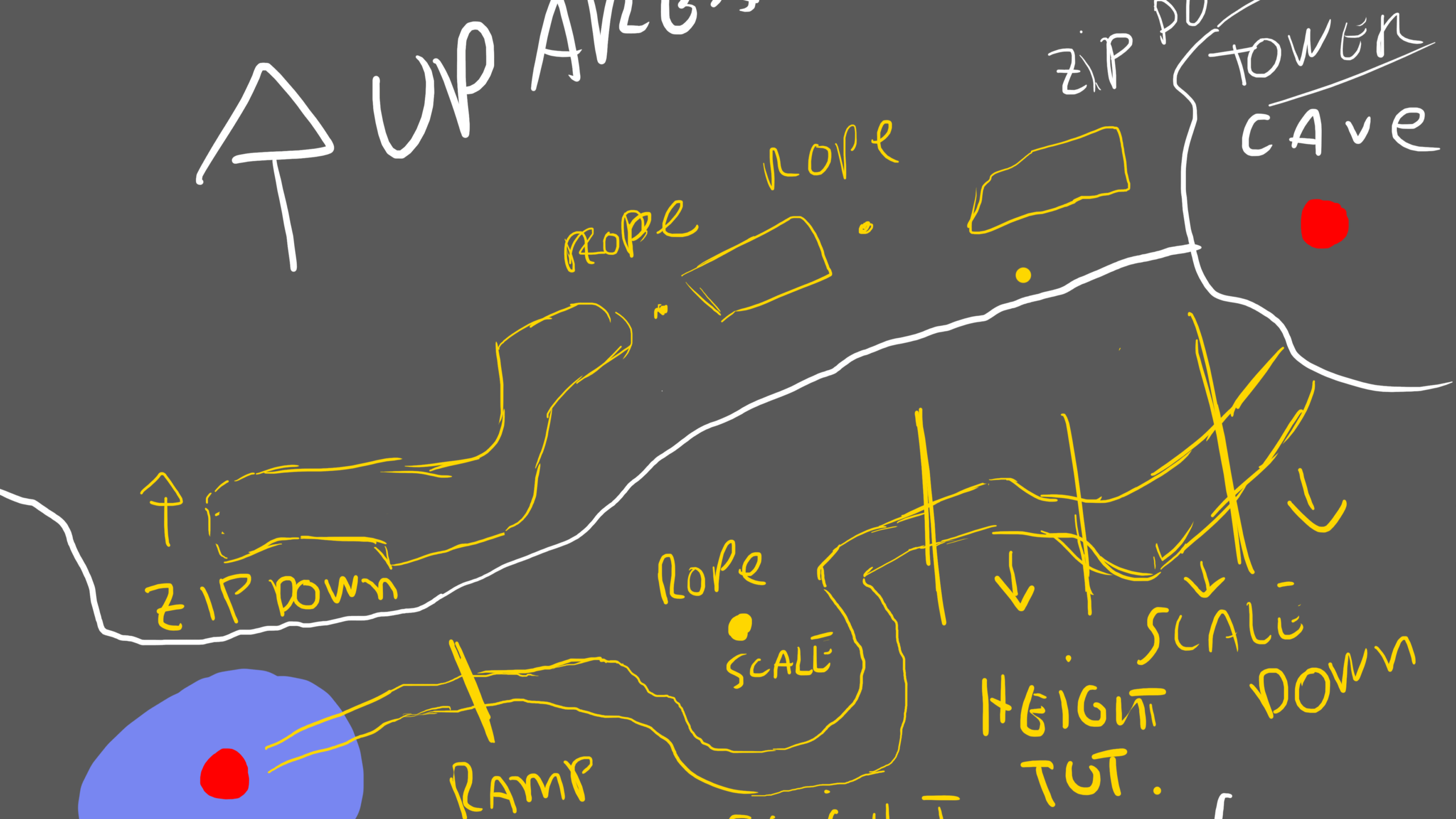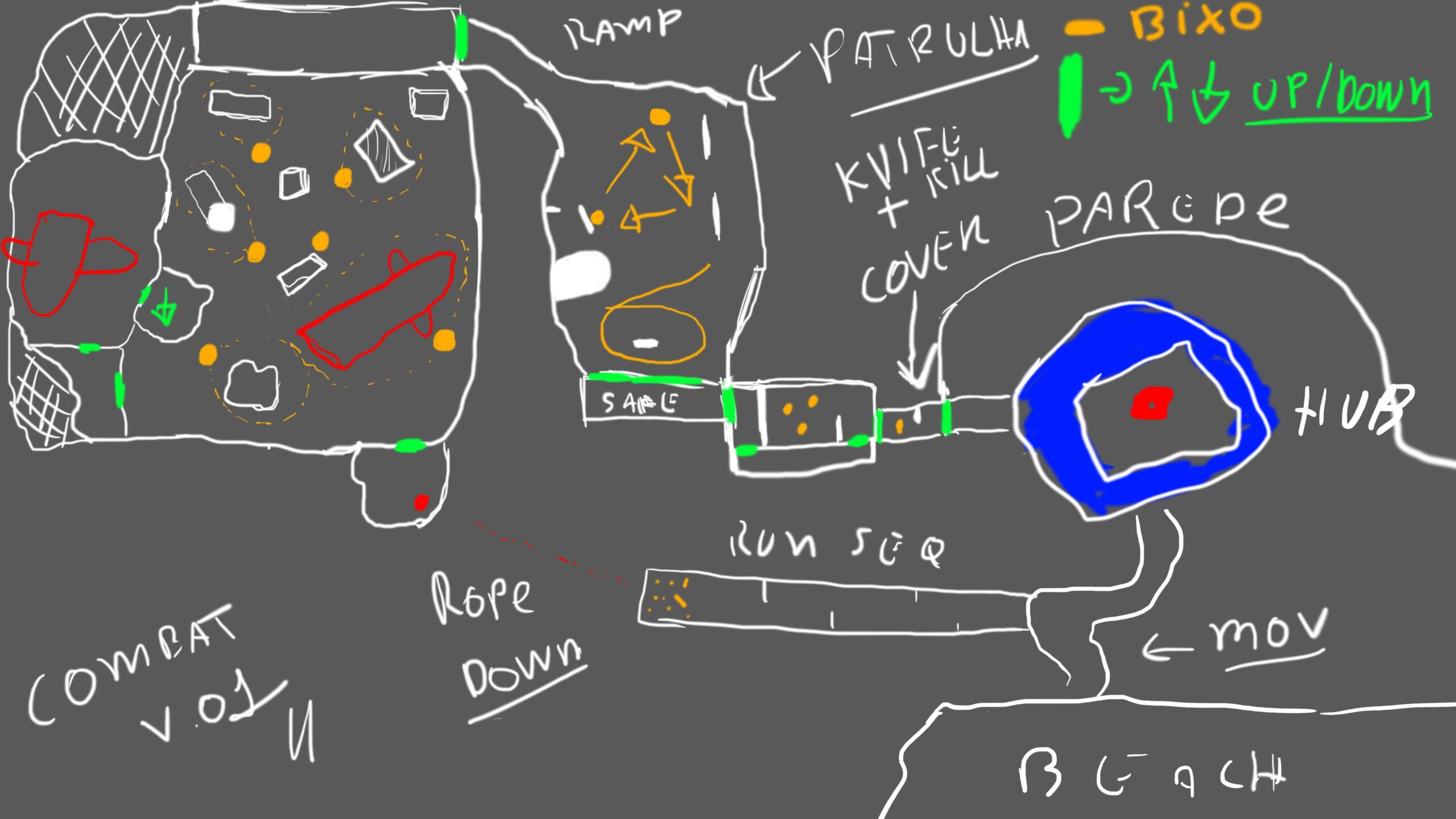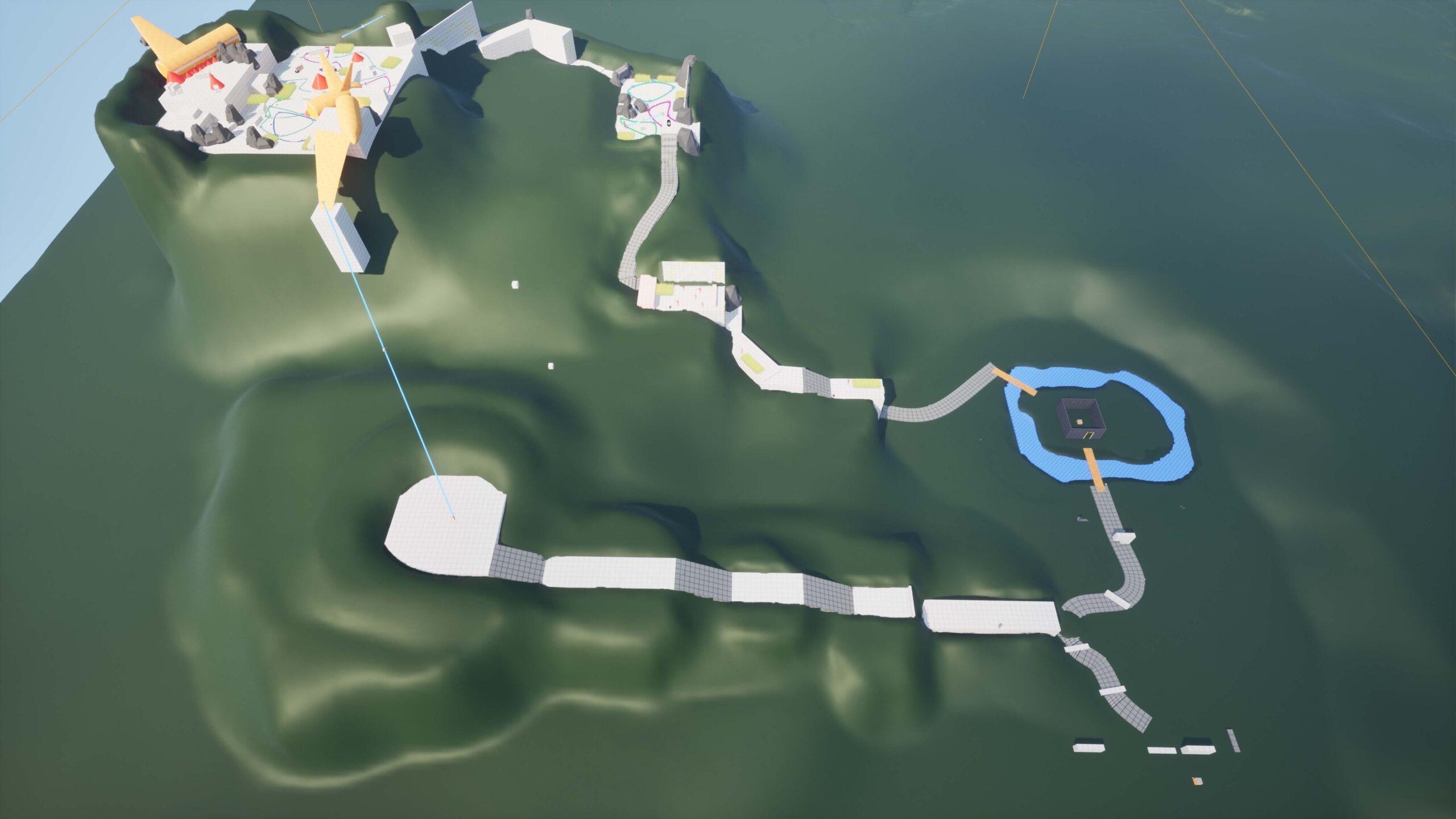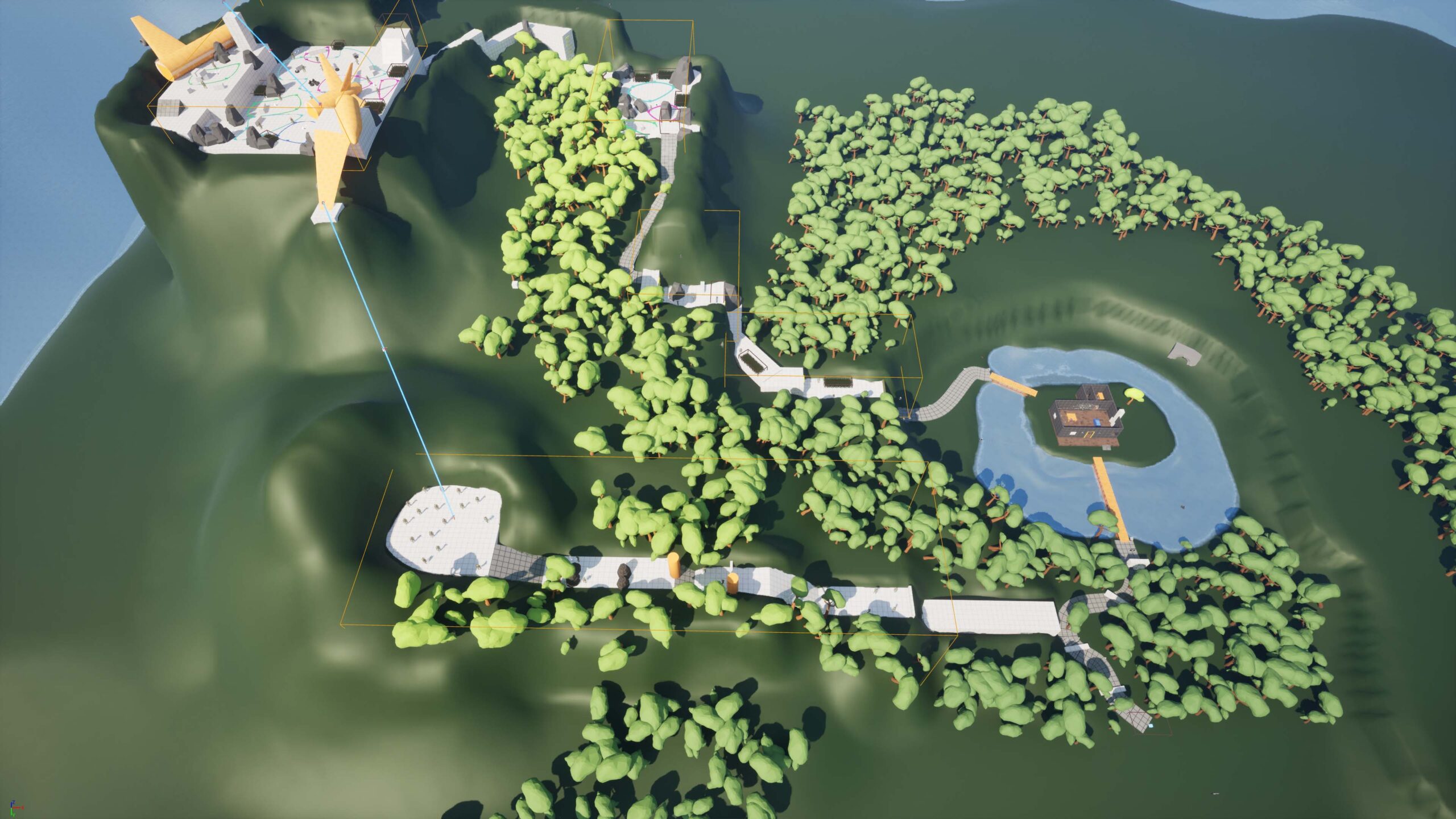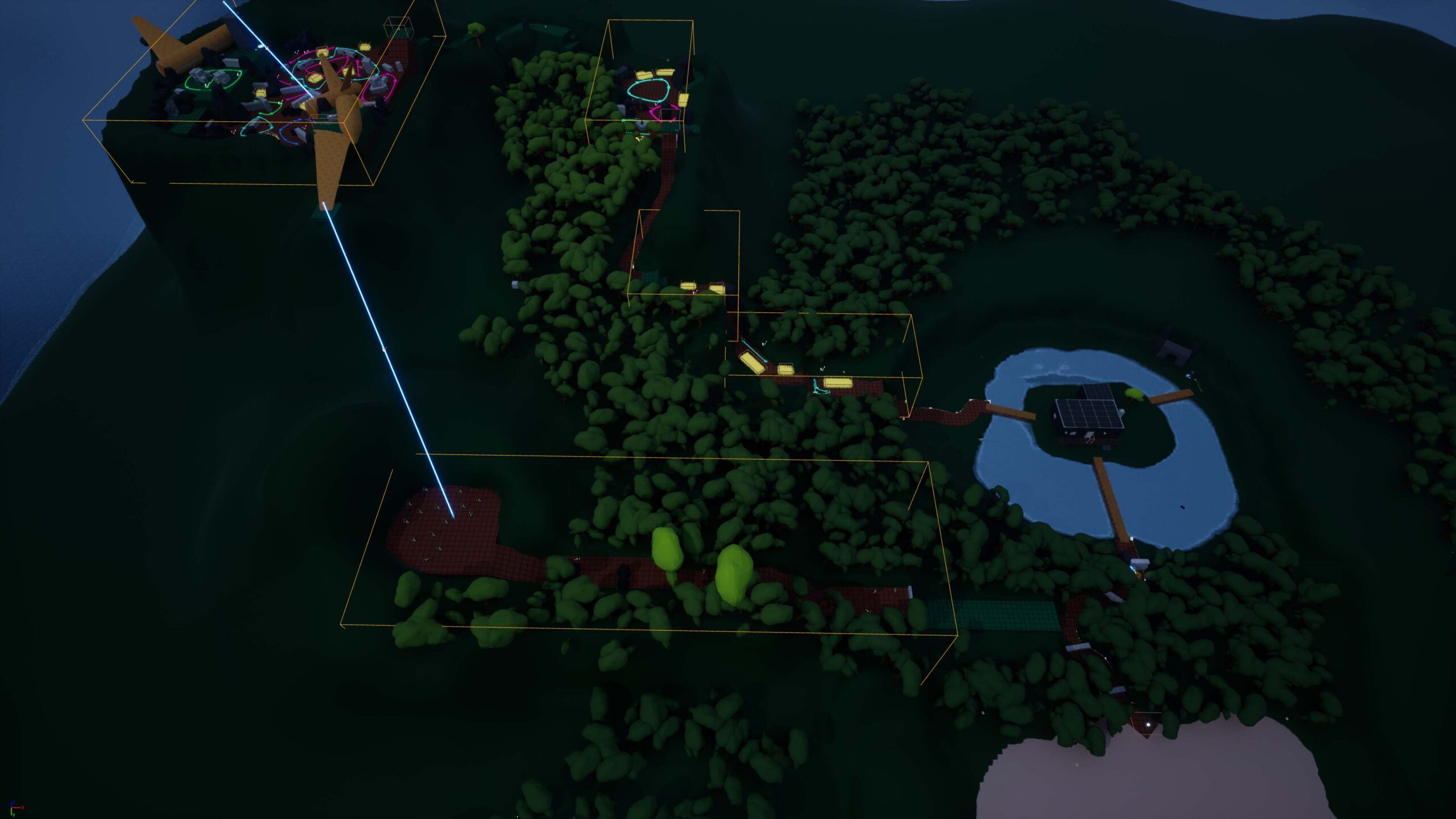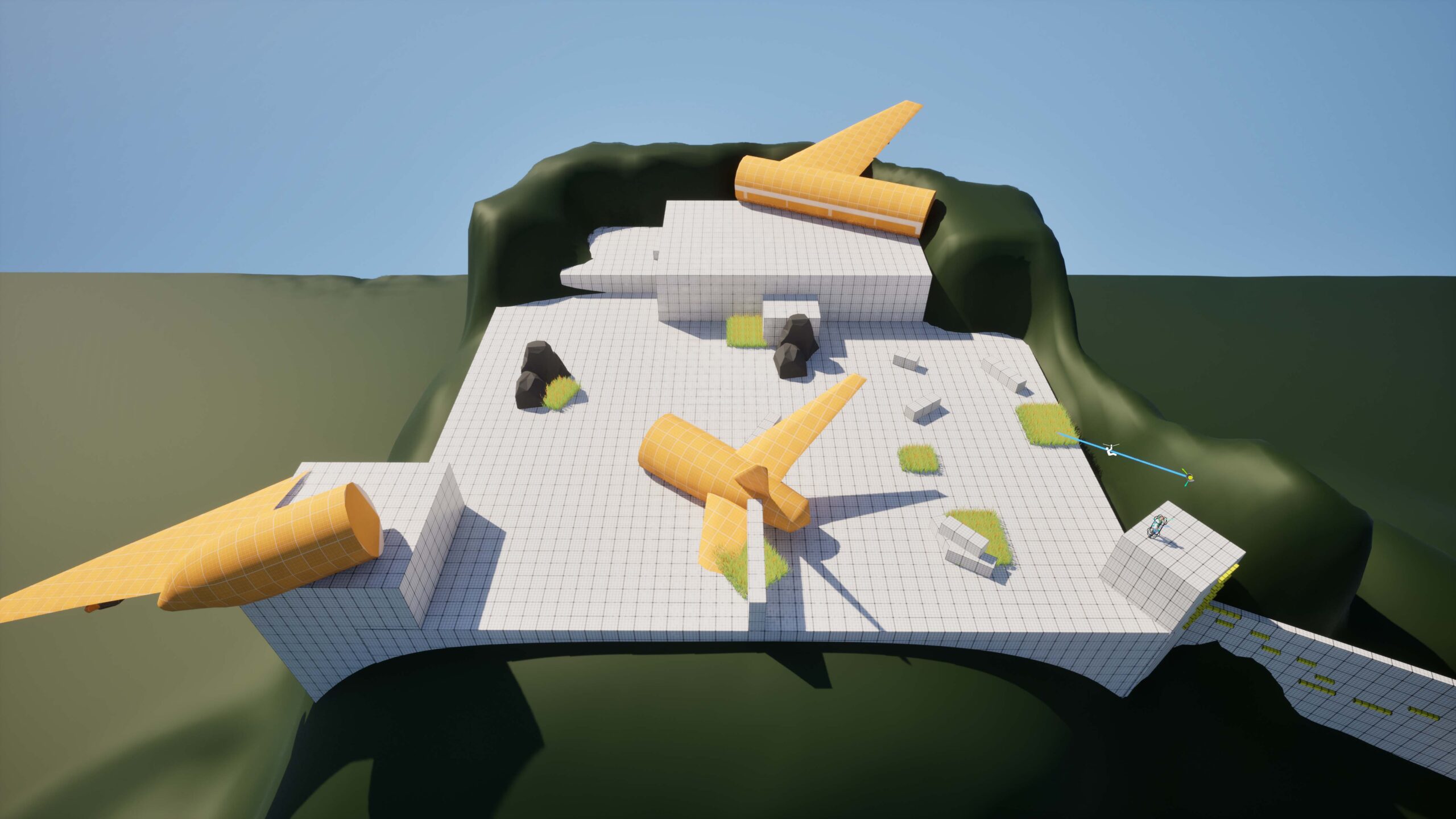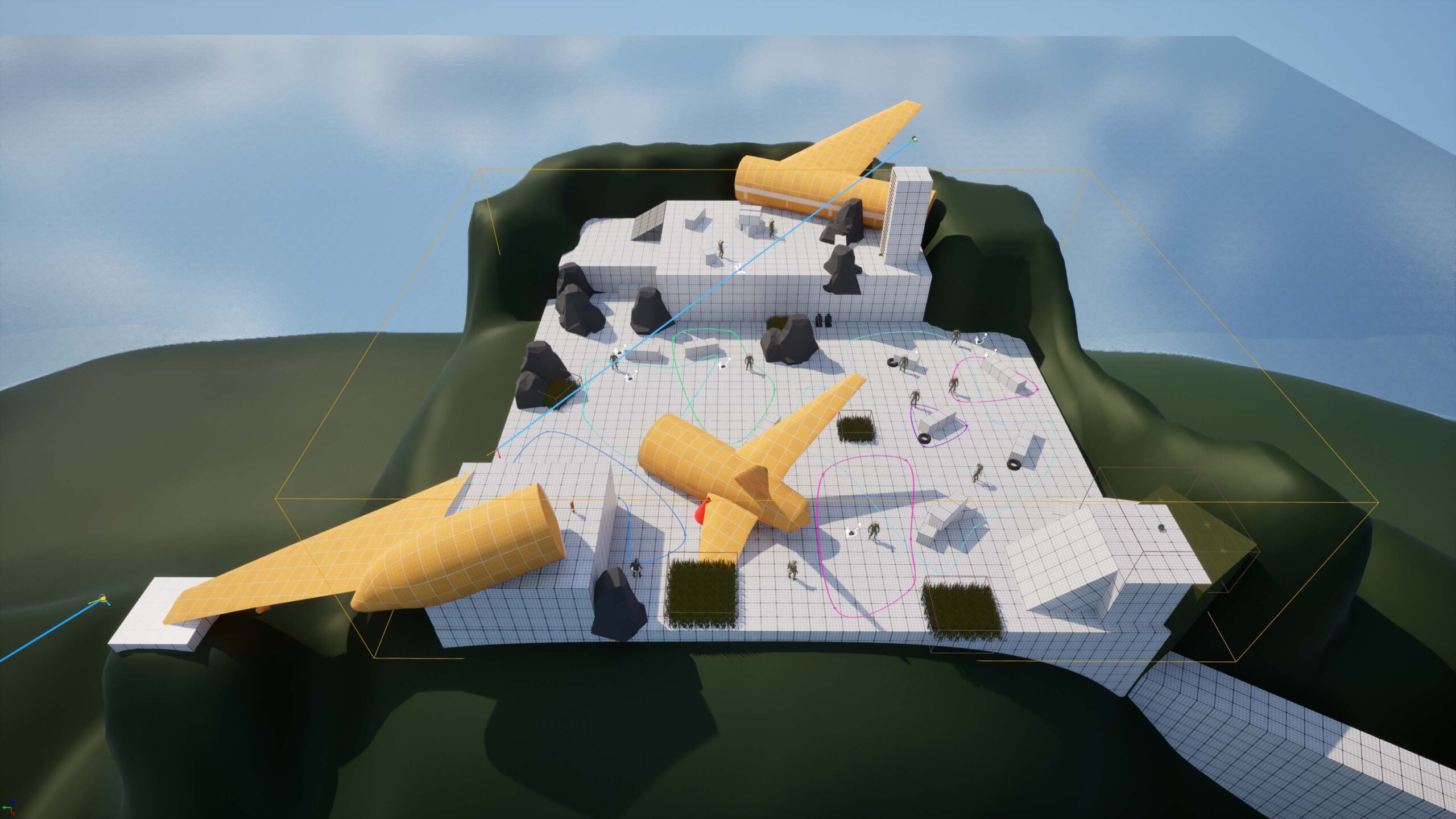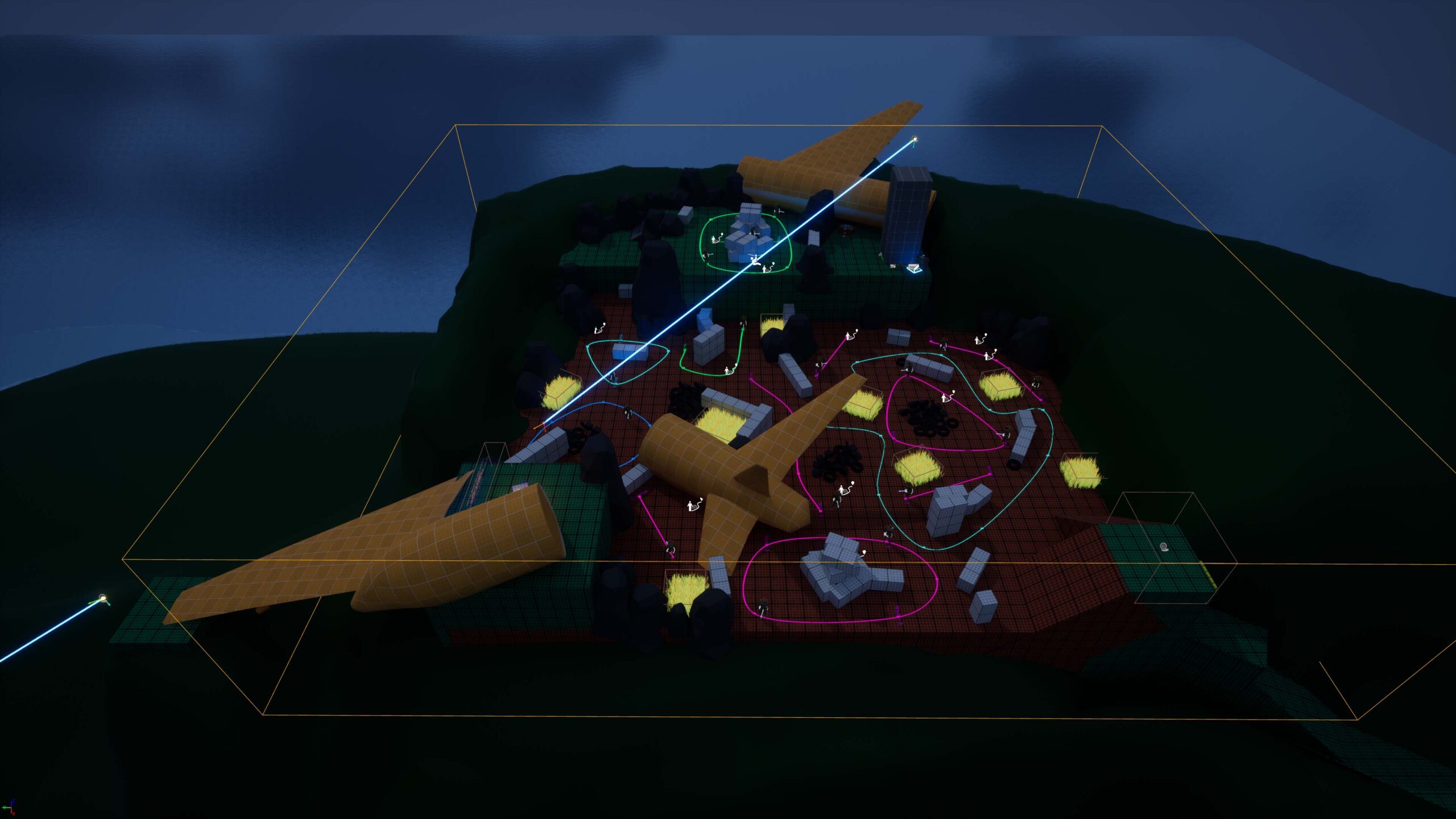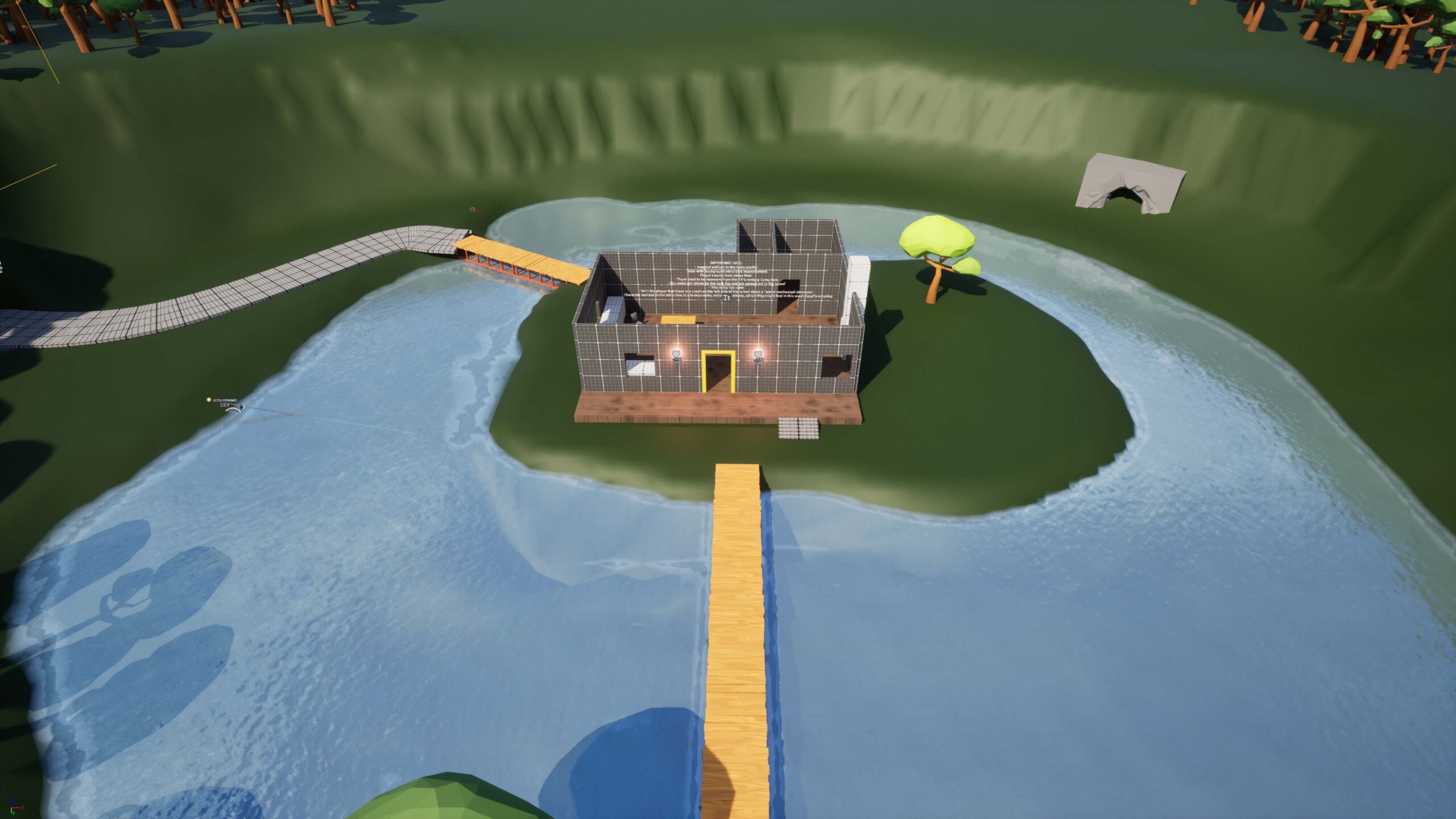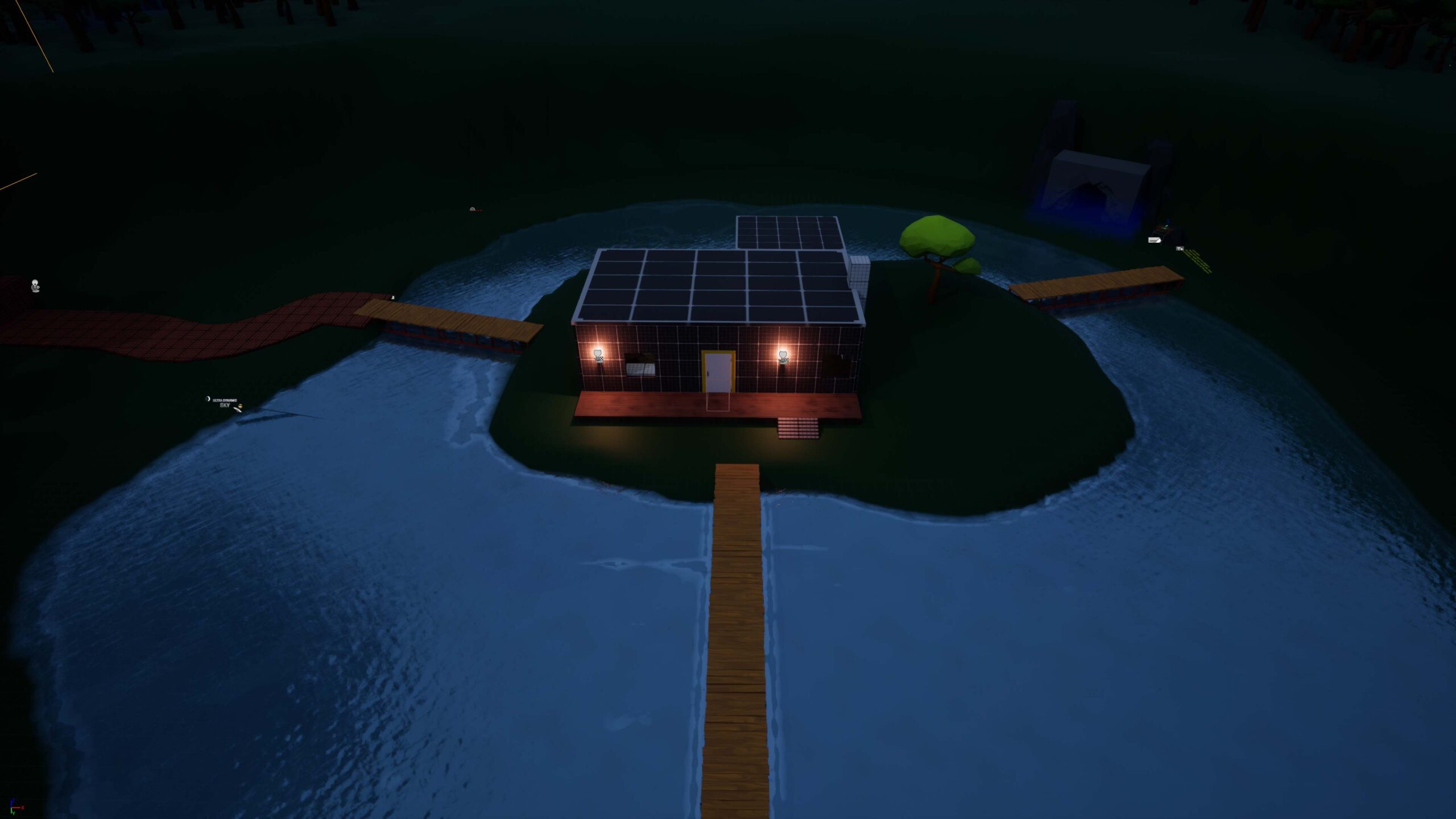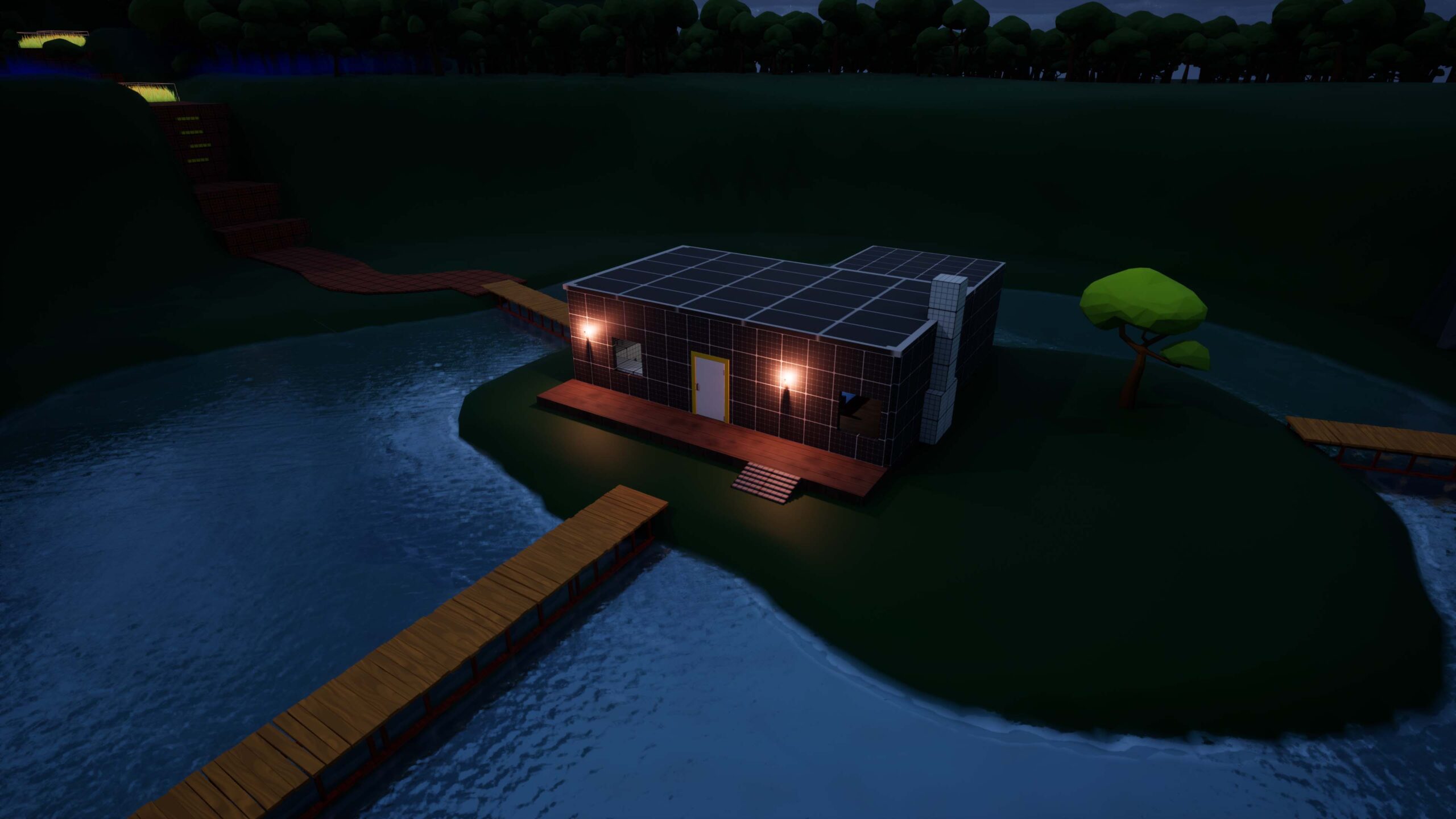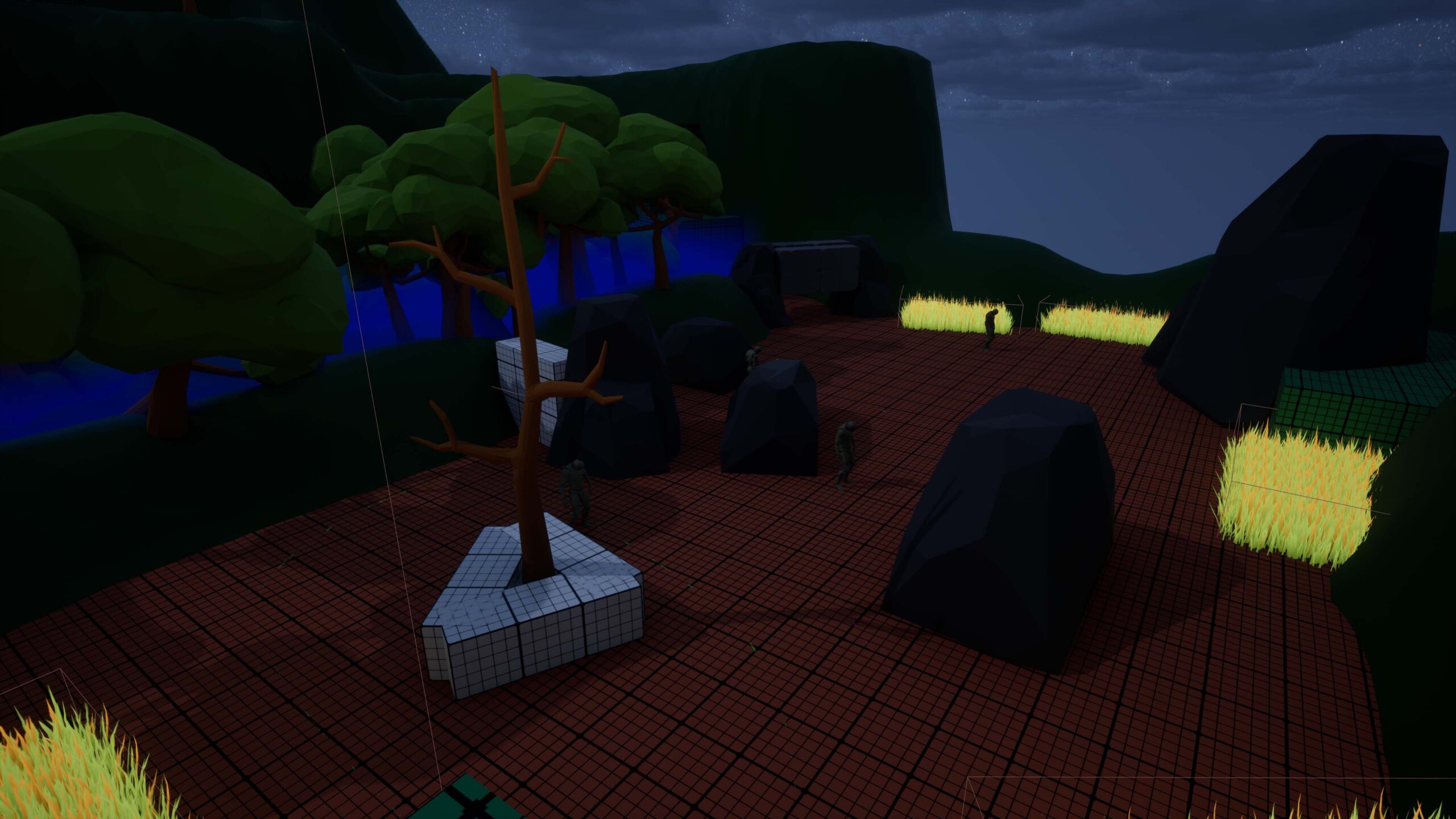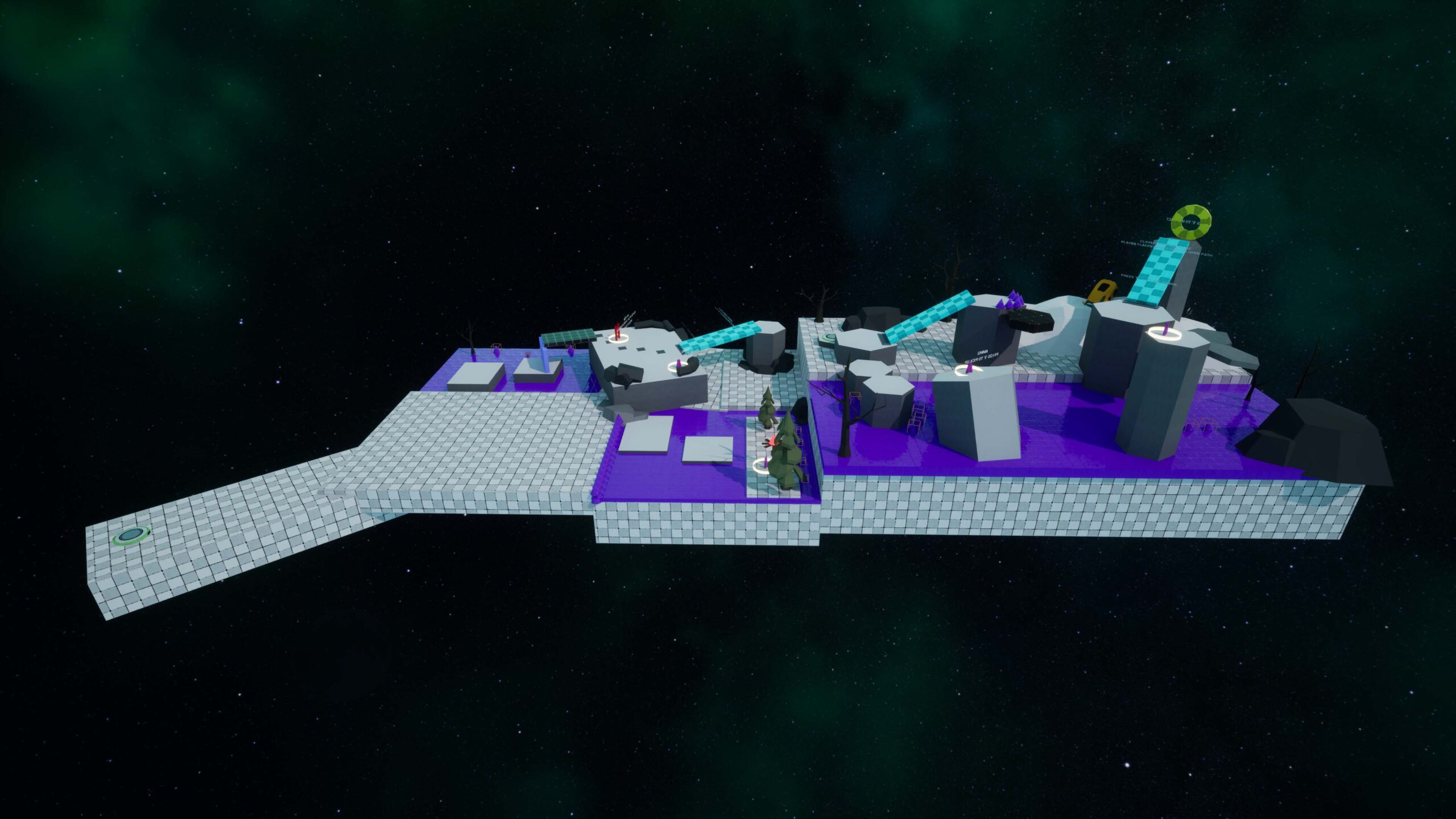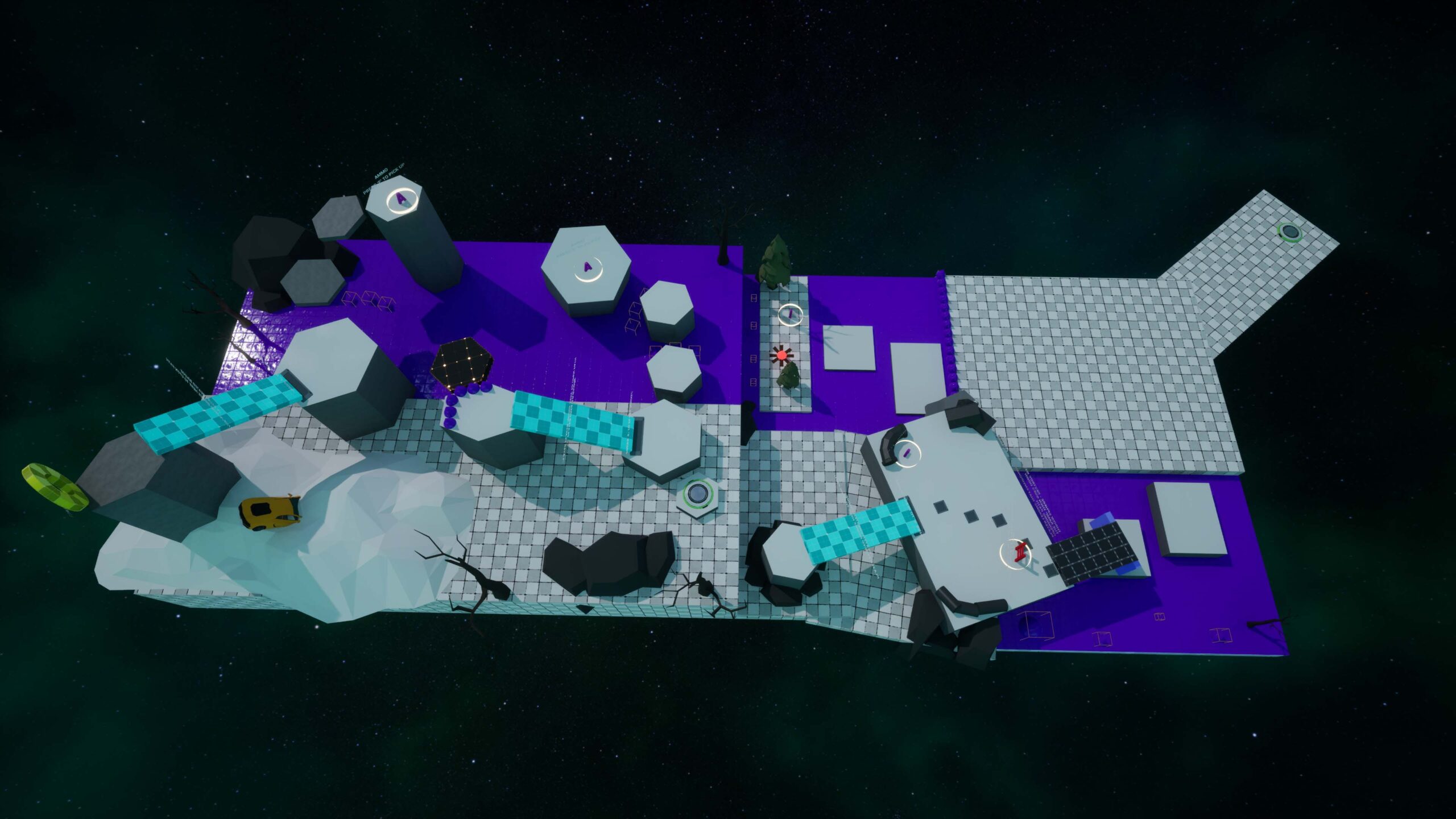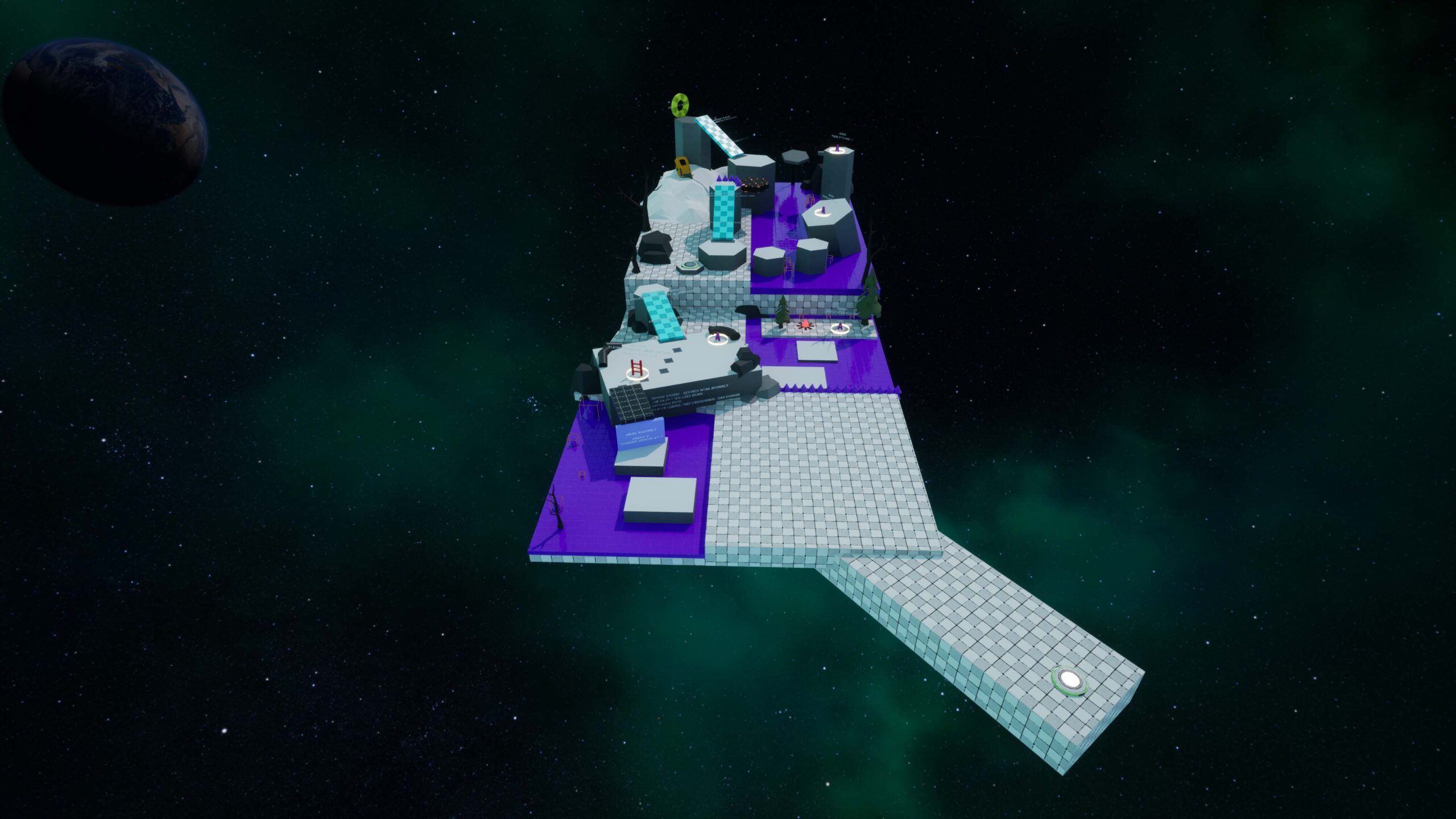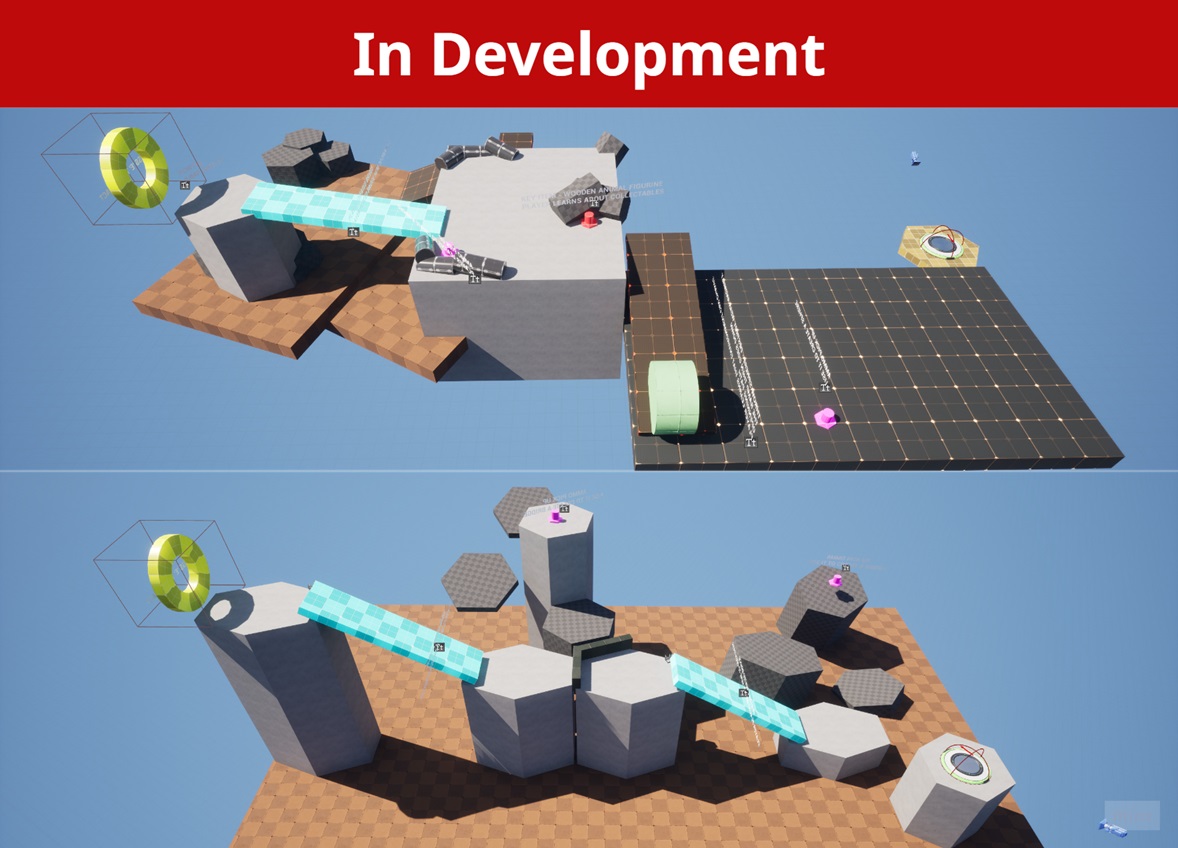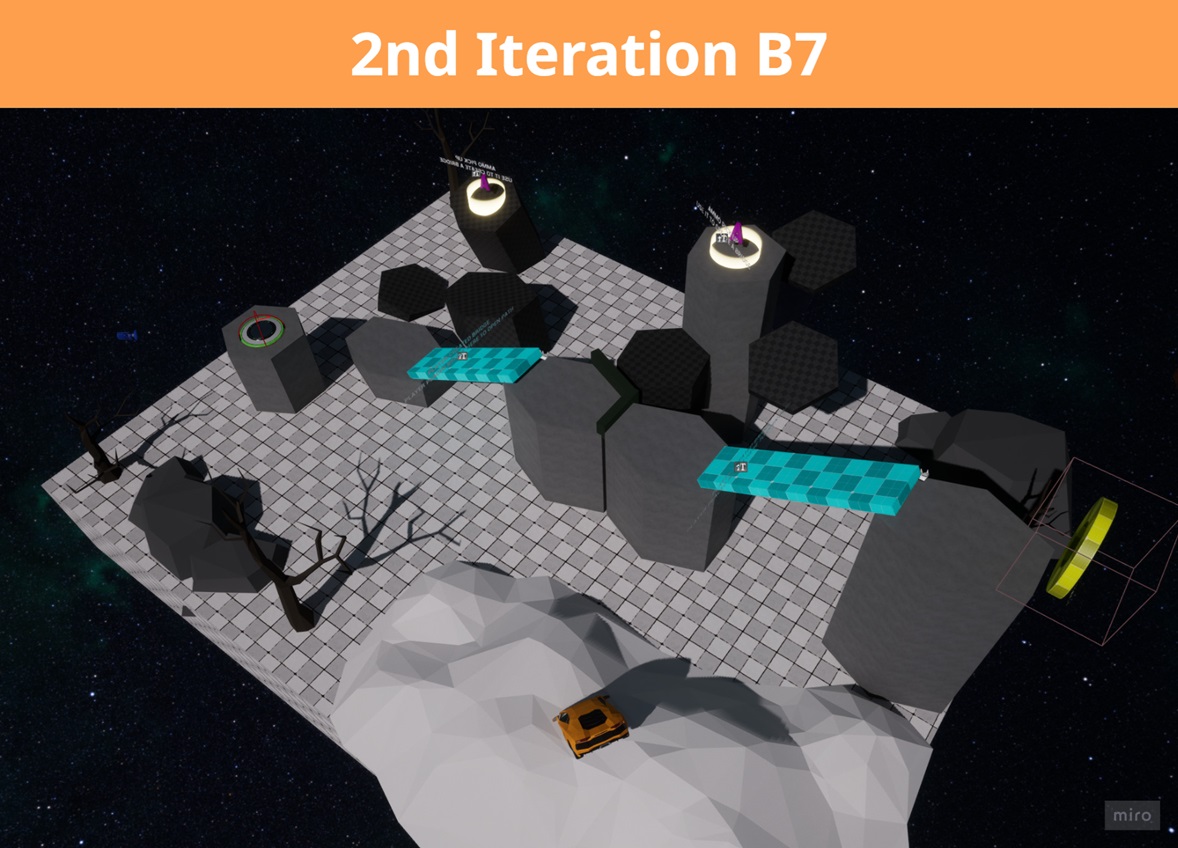Project: Driftsend
- Genre: 3D Adventure
- Type: Blockout
- Engine: Unreal Engine 5
- Tools: JakubW, UltraDynamicSky, BlockingStarterPack, LevelDesignKit
- Iterations # 4
- Playtests # 4
- Role: Combat & Level Designer
Goal
Driftsend was conceived to dive deep into combat design within an immersive, semi-linear experience. My primary goal was to create a concise, impactful adventure, demonstrating mastery in:
- Purposeful spaces: Areas designed with narrative and gameplay intent.
- Gameplay rhythm: Balancing tension, stealth, and action.
This project was an opportunity to prove my ability to blend tension, mystery, and moments of strategic combat, culminating in a short but memorable journey that highlights my technical and creative prowess.
Progress
Overview
Setting: Driftsend drops players onto a remote island after a shipwreck. Stranded, they find an abandoned house, a crucial safe haven and central hub, with a broken radio as their only hope.
Constraint: A three-week deadline drove rigorous decisions, focusing on essential gameplay for a refined, functional experience.
Design Pillars
Purposeful Adventure: Guiding the player through a journey where every space and encounter serves a clear narrative or mechanical purpose.
Sense of Isolation: Amplifying the feeling of being stranded and alone on a mysterious island.
Decision-Focused Combat: Emphasizing strategic choices and resourceful use of environment and abilities in enemy encounters.
Highlights
Main Hub
The abandoned house functions as Driftsend’s central hub, strategically designed as the player’s primary anchor and a vital safe haven, visually contrasting with the hostile, isolating wilderness.
- Player Reinforcement: This spatial design choice provides a clear psychological and functional safe waypoint.
Stealth - Combat Approach
This highlight introduces a core combat mechanic: the stealth kill. Leveraging the Jakub’s Controller zombie AI, this system empowers the player to silently neutralize threats, offering a powerful alternative to direct confrontation.
- Strategic Empowerment: It provides the player with a tactical choice, rewarding observation and calculated engagement over brute force, integrated seamlessly as the protagonist’s “magic artifact” (knife).
Stealth - No Combat Approach
Beyond direct elimination, the level design also provides viable “no combat” stealth options. Players can strategically bypass enemy encounters entirely, utilizing environmental elements and alternative routes to progress.
- Player Agency: This design choice fosters player agency by offering distinct paths and encouraging resource management, allowing for tension-filled traversal without requiring direct engagement.
Techniques
One-Way Valves
The level design strategically incorporates one-way valves, guiding player progression through specific areas without allowing backtracking.
Controlled Flow: Ensures deliberate, forward player advancement.
Narrative Focus: Maintains tension and prevents disorientation.
Resource Optimization: Prevents re-entry into cleared zones, streamlining the experience.
Vantage Point
Key areas within Driftsend feature strategically placed vantage points, providing players with elevated perspectives of upcoming challenges.
Tactical Planning: Enables players to observe and plan approaches (stealth, evasion, combat).
Situational Awareness: Enhances understanding of layouts and potential threats.
Informed Decisions: Empowers players to assess risk and identify optimal route.
Foreshadowing
Driftsend uses environmental foreshadowing to build player anticipation, with visual cues hinting at upcoming challenges or story beats.
Player Engagement: Creates curiosity and subtly prepares players for future events.
Narrative Depth: Organically integrates plot elements into the visual landscape.
Contextual Understanding: Enhances player comprehension of the level’s flow.
Rebooting
Rebooting the idea
The Driftsend concept was redefined due to crucial viability needs. The original scope proved unfeasible, and gameplay simulation faced technical hurdles. So, the project was optimized for a 2-3 week cycle, allowing for a concise, polished delivery, driven by:
Jakub’s AI: Solved a technical blocker, enabling combat design and new portfolio expertise.
Focused Experience: Resulted in a semi-linear game balancing tactical combat, exploration, and environmental storytelling.
The table below discusses the main elements that changed between the original and rebooted project versions.
| Element | Previous Version | Current Version (Reboot) |
|---|---|---|
| Scope | Long (8–10 weeks) | Short (2–3 weeks) |
| Narrative Structure | 3 acts: broad exploration + 2 main objectives | Straightforward line with 12 defined beats |
| Objective | Retrieve 2 components (antenna and power source) for the radio | Same objective, but focused on a single object and route |
| AI / Enemies | Undefined, hard to blockout concept | Zombies via Jakub’s Controller, effectively simulates the monster |
| Combat Mechanics | Absent (undefined due to implementation limitations) | Stealth kill, ignore enemies, rush, knife-based combat |
| Progression Style | Semi-open with backtracking between locations | Linear/semi-open with direct route (round-trip between 2 points) |
| Exploration Area | Full island with multiple locations (mine, plane, tower, etc.) | Only the beach, hub, and crash site area |
| Narrative Density | High (story with symbols, entities, supernatural elements) | Preserved, but conveyed through visuals and pacing |
| Learning Focus | Storytelling, level composition, environmental design | Combat design, pacing, semi-open world structure |
| Tools | Unreal Engine 5, Miro, Photoshop | Same tools, greater focus on playable blockout |
| Technical Viability | Limited (issues with scripting, AI, rhythm) | High (everything testable with currently available tools) |
For example, the figure on the left below shows the initial idea’s island-wide PoI blockout. The right figure, after the reboot, focuses predominantly on the island’s west side, showcasing the refined scope.
Progressive Learning Curve Design
Learning: Hidden Bush and Enemy Kill
Result
Initially designed for platforming and bridge tutorials, the Snow Zone changed during development:
Hazard elements were added to the environment.
The setting was reimagined as a snowy junkyard.
The zone reflects environmental impact caused by the anomaly.
First & Second Iteration
Beat 6 and Beat 7 were initially structured to deepen engagement with platforming and bridge mechanics:
Reinforce movement skills
Introduce bridge ability in practice
Changes to the level’s metrics prompted a redesign of Beat 7.
Solution:
The redesign emphasized:
Reduced redundancy
Alternative paths for recovery
Early integration of mechanics appearing in later gameplay
Results:
Mechanics loop back into later beats
Layout matches updated pacing expectations
Third & Fourth Iteration
Player’s test indicated that the main path was too narrow and rigid. To improve flexibility, I expanded the playable area during iteration 3 and 4.
Merge B7 and B8 into a single larger space.
During the fourth iteration, a playtest revealed pacing and clarity issues.
Problems:
Confusion around bridge mechanics
Idle time between gameplay points
Lack of environmental threats
Solution:
Reintroduced a key item for bridge creation
Tightened space between gameplay moments
Added environmental hazards
Learning: Stealth Approach
Result
Initially designed for platforming and bridge tutorials, the Snow Zone changed during development:
Hazard elements were added to the environment.
The setting was reimagined as a snowy junkyard.
The zone reflects environmental impact caused by the anomaly.
First & Second Iteration
Beat 6 and Beat 7 were initially structured to deepen engagement with platforming and bridge mechanics:
Reinforce movement skills
Introduce bridge ability in practice
Changes to the level’s metrics prompted a redesign of Beat 7.
Solution:
The redesign emphasized:
Reduced redundancy
Alternative paths for recovery
Early integration of mechanics appearing in later gameplay
Results:
Mechanics loop back into later beats
Layout matches updated pacing expectations
Third & Fourth Iteration
Player’s test indicated that the main path was too narrow and rigid. To improve flexibility, I expanded the playable area during iteration 3 and 4.
Merge B7 and B8 into a single larger space.
During the fourth iteration, a playtest revealed pacing and clarity issues.
Problems:
Confusion around bridge mechanics
Idle time between gameplay points
Lack of environmental threats
Solution:
Reintroduced a key item for bridge creation
Tightened space between gameplay moments
Added environmental hazards
Learning: Enemy Patrol & Player Choices
Result
Initially designed for platforming and bridge tutorials, the Snow Zone changed during development:
Hazard elements were added to the environment.
The setting was reimagined as a snowy junkyard.
The zone reflects environmental impact caused by the anomaly.
First & Second Iteration
Beat 6 and Beat 7 were initially structured to deepen engagement with platforming and bridge mechanics:
Reinforce movement skills
Introduce bridge ability in practice
Changes to the level’s metrics prompted a redesign of Beat 7.
Solution:
The redesign emphasized:
Reduced redundancy
Alternative paths for recovery
Early integration of mechanics appearing in later gameplay
Results:
Mechanics loop back into later beats
Layout matches updated pacing expectations
Third & Fourth Iteration
Player’s test indicated that the main path was too narrow and rigid. To improve flexibility, I expanded the playable area during iteration 3 and 4.
Merge B7 and B8 into a single larger space.
During the fourth iteration, a playtest revealed pacing and clarity issues.
Problems:
Confusion around bridge mechanics
Idle time between gameplay points
Lack of environmental threats
Solution:
Reintroduced a key item for bridge creation
Tightened space between gameplay moments
Added environmental hazards
Escalating: Putting everything in practice
Result
Initially designed for platforming and bridge tutorials, the Snow Zone changed during development:
Hazard elements were added to the environment.
The setting was reimagined as a snowy junkyard.
The zone reflects environmental impact caused by the anomaly.
First & Second Iteration
Beat 6 and Beat 7 were initially structured to deepen engagement with platforming and bridge mechanics:
Reinforce movement skills
Introduce bridge ability in practice
Changes to the level’s metrics prompted a redesign of Beat 7.
Solution:
The redesign emphasized:
Reduced redundancy
Alternative paths for recovery
Early integration of mechanics appearing in later gameplay
Results:
Mechanics loop back into later beats
Layout matches updated pacing expectations
Third & Fourth Iteration
Player’s test indicated that the main path was too narrow and rigid. To improve flexibility, I expanded the playable area during iteration 3 and 4.
Merge B7 and B8 into a single larger space.
During the fourth iteration, a playtest revealed pacing and clarity issues.
Problems:
Confusion around bridge mechanics
Idle time between gameplay points
Lack of environmental threats
Solution:
Reintroduced a key item for bridge creation
Tightened space between gameplay moments
Added environmental hazards


